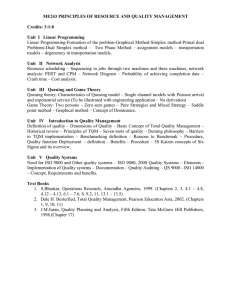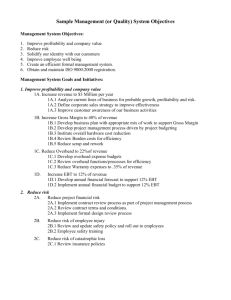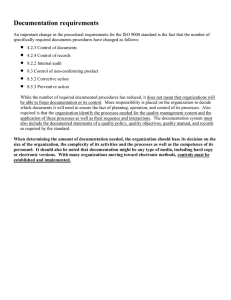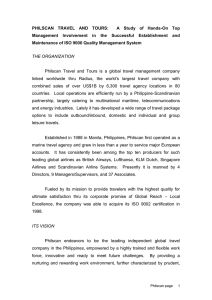Effects of ISO 9000 certification on companies` profitability: an
advertisement
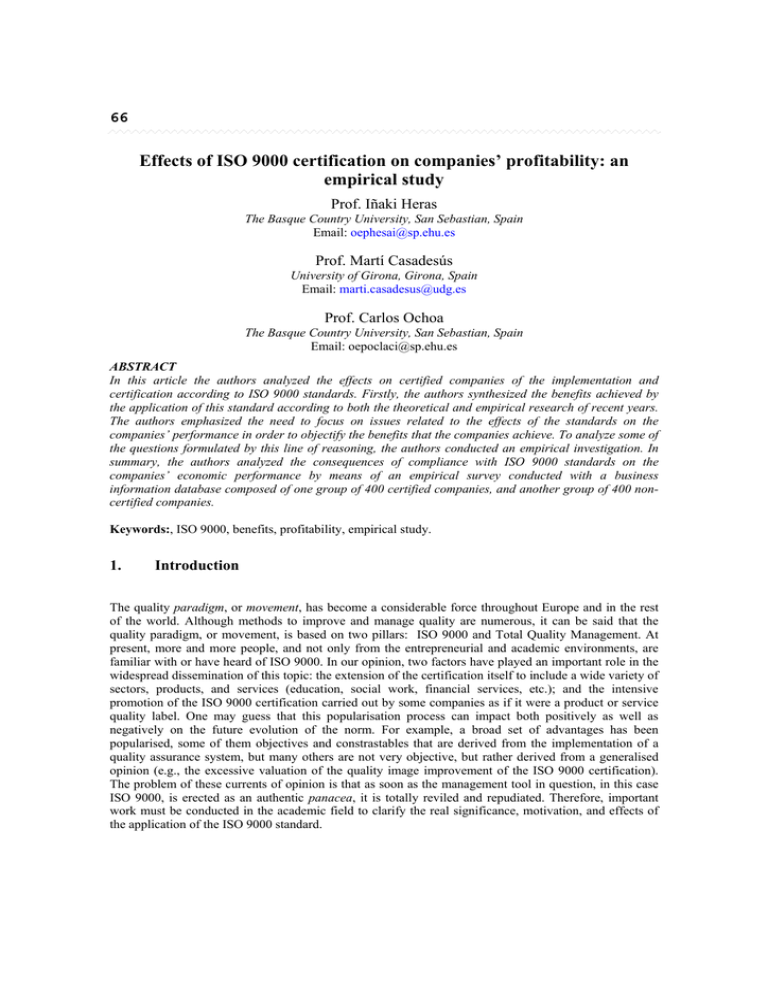
66 Effects of ISO 9000 certification on companies’ profitability: an empirical study Prof. Iñaki Heras The Basque Country University, San Sebastian, Spain Email: oephesai@sp.ehu.es Prof. Martí Casadesús University of Girona, Girona, Spain Email: marti.casadesus@udg.es Prof. Carlos Ochoa The Basque Country University, San Sebastian, Spain Email: oepoclaci@sp.ehu.es ABSTRACT In this article the authors analyzed the effects on certified companies of the implementation and certification according to ISO 9000 standards. Firstly, the authors synthesized the benefits achieved by the application of this standard according to both the theoretical and empirical research of recent years. The authors emphasized the need to focus on issues related to the effects of the standards on the companies’ performance in order to objectify the benefits that the companies achieve. To analyze some of the questions formulated by this line of reasoning, the authors conducted an empirical investigation. In summary, the authors analyzed the consequences of compliance with ISO 9000 standards on the companies’ economic performance by means of an empirical survey conducted with a business information database composed of one group of 400 certified companies, and another group of 400 noncertified companies. Keywords:, ISO 9000, benefits, profitability, empirical study. 1. Introduction The quality paradigm, or movement, has become a considerable force throughout Europe and in the rest of the world. Although methods to improve and manage quality are numerous, it can be said that the quality paradigm, or movement, is based on two pillars: ISO 9000 and Total Quality Management. At present, more and more people, and not only from the entrepreneurial and academic environments, are familiar with or have heard of ISO 9000. In our opinion, two factors have played an important role in the widespread dissemination of this topic: the extension of the certification itself to include a wide variety of sectors, products, and services (education, social work, financial services, etc.); and the intensive promotion of the ISO 9000 certification carried out by some companies as if it were a product or service quality label. One may guess that this popularisation process can impact both positively as well as negatively on the future evolution of the norm. For example, a broad set of advantages has been popularised, some of them objectives and constrastables that are derived from the implementation of a quality assurance system, but many others are not very objective, but rather derived from a generalised opinion (e.g., the excessive valuation of the quality image improvement of the ISO 9000 certification). The problem of these currents of opinion is that as soon as the management tool in question, in this case ISO 9000, is erected as an authentic panacea, it is totally reviled and repudiated. Therefore, important work must be conducted in the academic field to clarify the real significance, motivation, and effects of the application of the ISO 9000 standard. Part 2: ISO 9000:2000 SA 8000 & SMS 67 From the academic area, one must outline that the greatest part of Quality Management literature consists of articles of a normative character, so that, consequently, there is not much research done on the practical effects of Quality Management. Recently, the eminent J. M. Juran, one of the most important quality gurus and a well known critic of some aspects related to the standard, noted the lack of research that can shed light on the “benefit we are getting from all that costly certification to the ISO 9000 series of standards” [Juran, 1999]. Nevertheless, though the deficit related to investigations of empirical character is evident, it is also true that more and more survey works on ISO 9000 are being published across the world. Despite the proliferation of surveys, Juran’s criticism appears justified, since the majority of the surveys focus on describing the characteristics of the certified companies and analysing their motivations for certification according to the ISO 9000 standard, and generally have the same conclusions. But, what are the benefits that companies obtain as they implement the ISO 9000 standard? 2. ISO 9000 implementation benefits Unfortunately, some of the benefits derived from the ISO 9000 certification are unclear, while others are open to different interpretations or measuring problems (for example, the rise in productivity, or the increase in market share) [Jones, et al., 1997]. Despite the difficulties in quantifying and measuring the said benefits, it is usual for the literature to make a distinction between “internal” and “external” aspects of the company [Tsiotras and Gotzamandi, 1996; Lloyd’s Register Quality Assurance Ltd., 1994; Vloegeberhgs and Bellen, 1996]. It has to be said that there are fewer investigations on the benefits that the ISO 9000 standard has brought than there are investigations of the motivation for the standard. At the same time, the results of these investigations are often confused and unequal. For example, while some of the investigations specifically indicate an improvement in the organization, others emphasize only the marketing contributions. While studying the importance of the internal benefits related to the external, we encountered distinct opinions. Vloegeberhgs and Bellen [1996] state that the majority of the benefits obtained with the certification are of an internal nature. According to Brown, et al. [1998], although the majority of the SMEs are certified for external reasons, the most important benefits are of an internal character, such as: improvement in the awareness of the importance of quality, improvement in the awareness of the company’s problems, and improvement in product quality. On the other hand, Quazi and Padijbo [1998] state that the most important benefits are of an external nature, the three most important of which include: an increase in customer satisfaction, an improvement of product quality and competitiveness in the market, and the satisfaction of customer requirements. According to another study of 160 Australian companies [Brown and Van der Wiele, 1995], the benefits obtained with the certification include the following: Increase in the company’s quality awareness, increase in product quality awareness, improved company management, improved customer relations, improved products and services offered, improved relationship within the organization, increase in customer satisfaction, and increase in respect from competitors. On the other hand, according to another study carried out in the United Kingdom [Lloyd’s Register Quality Assurance, 1994], the benefits of certification can be summarized as an important marketing tool that helps market relations, increases the possibility of obtaining new contracts, decreases the number of customer audits, and assists in entering international markets. Obviously one can consider the results of this study to be biased, because the investigating organization is directly involved in the application of the ISO 9000 standard. But another study conducted by an important consulting company [Vanguard Consulting, 1994] confirms that only 15% of the companies obtained the benefits that the British Standards Institution set. In line with this researches, the authors of this article conducted a study in Spain from 1997 to 1999 of 500 Spanish companies in two of the country’s most productive autonomous regions, Catalonia 68 and The Basque Country. This investigation followed a larger number of certified companies with a greater diversification of activities than other studies. The authors studied issues related to ISO 9000 registration in an effort to analyze the effects produced by the application of the standard [Casadesús, Heras and Ochoa, 2000]. To summarize, the empirical evidence analyzed shows that the most important internal benefits of the application of the standard include the following: Improvement of the definition and standardization of the work procedures (33%), improvement in the definition of the responsibilities and obligations of the workers (19%), increase in the company’s quality confidence (11%), better involvement in work (11%), and improvement in guidelines which reduce improvisation (7%). All other aspects were deemed of minor importance. These results are similar, with some exceptions, to other research on the internal benefits of the normative. For example, in an investigation of special relevance carried out in 1,220 companies, Buttle [1997] noted that the most important internal benefits include: Improvement in efficiency, improvement in work procedures, improvement in management and control of the company, decrease of problems with procedures, and increase in the motivation of the workers. Another important contribution of the standard is the use of the data collected by the implementation for strategic and/or operational purposes. In 95% of the companies, this data is used, contradicting the study by Goh and Ridgway [1994], where the majority of companies did not see any advantage in analyzing this quality cost. Furthermore, most of the companies (91%) claim that certification has benefited them, particularly due to the opportunity to restructure their organizations and to determine the responsibilities of each work place. On the other hand, in the quoted investigation [Casadesús, Heras and Ochoa, 2000], the most important external benefits of the ISO 9000 implementation are: Increased response of client requirements (34%), access into new markets (21%), improvement in customer relations (18%), improvement in services to customers (16%), and decrease of customer audits (8%). The great commercial importance and image quality offered by the standard is reinforced by these results because none are related to a real improvement in quality. Another benefit of the certification is its positive influence on the financial aspects of the company. 58% of the companies believe that the standard allowed a considerable increase in their market share, as well as a significant increase in their companies’ trend. Therefore, these results resemble those of Lloyds Register Quality Assurance Ltd. [1994], which stated that in 49% of the cases the companies had benefited from the certification due to an increase in the market share obtained. 3. Effects on companies’ profitability Although we think that these surveys are important to delve into the effects of the ISO 9000 standard, one cannot ignore their inherent weakness and methodological distortion, since in order to asses the effects of the ISO 9000 implementation process, the surveys collect the opinions of the directors of the affected companies. For this reason, we believe in the importance of evaluating the effects of the standard by more objective indicators, such as productivity, reduction in product defects or profitability, not based on the opinion of managers. Among the specialists in this field of research, there has been an intense discussion on whether the application of the ISO 9000 standard, or other Quality Management tools, is materialized in general and real economic earnings, or in improvement of the companies’ operating performance [see e.g. Adams, 1999 and Häversjö, 2000, where the relations between quality improvements and profitability are analyzed]. There are several studies by management consultant companies that verify that Total Quality programs have not been effective [Hendricks and Singhal, 1997]. These studies, as to be expected in this research area, have been extensively published and distributed throughout the business press. On the other hand, there is also evidence in favor of the companies that have gained quality excellence awards or certifications. According to a study carried out by two American academics between Part 2: ISO 9000:2000 SA 8000 & SMS 69 1987-1997, these companies have better sales performance, since the mean change in sales of companies that gained some type of quality award was 64% higher than the increase of the sales of the other companies [Hendricks and Singhal, 1997]. In another survey published by Lloyds Register Quality Assurance [LRQA, 1996], profit margins and return on capital employed of the certified companies averaged more than double the industry average. Likewise, recently it has been published a Danish study where the ISO certified companies seem to have a significantly higher rate of return than the non-certified ones [Häversjö, 2000]. Nevertheless, and for both types of evidences, for us it seems very important to stress that one should interpret the results of these studies with caution, due to the difficulty of quantifying the impact of quality management programs in tangible financial and economic results. 4. Empirical research: presentation and findings The research analyzed in this paper studies the effects of the ISO 9000 standard on the economic outcomes of the certified companies. The research geographically focused on the Basque Autonomous Community, which is considered one of the regions in all of Spain where the ISO 9000 certification has the greatest impact. The data gathered for this comparative study referred to a representative number of both ISO 9000 certified and non-certified companies in the Basque Autonomous Community. Also, it was estimated interesting to get data of more than an accounting year for each one of all the companies. The companies’ economic data was obtained from the Ardán database, an Entrepreneurial Information Service of the Consortium of the Exempt Zone of Vigo1. The Ardán database is one of the most complete at domestic level in Spain, for both economic and financial information, since it includes data for more than 100,000 companies, and more than 500 annual data by company and year. This data is recorded from, among other sources, the outcome and balance sheets that the companies submit to the Mercantile Register. For this investigation we used two samples from the ARDAN database: one sample of 400 ISO 9000 certified companies, and another sample of 400 non-certified companies. Data was available for the years 1994, 1995, 1996, 1997, and 1998, and included the sales revenue of each accounting year, as well as the profitability ratio (the ratio of net profit before interest and tax on total assets). Also, for the certified companies, the data set included information on their certification date. Before using these two samples, it was considered important to analyze the data in order to identify possible biases. For example, we studied the homogeneity of the samples to keep in mind some of the specific characteristics of the certified companies versus the non-certified companies. It can be argued that there is a certain degree of distortion due to the different average sizes of the certified companies in comparison with the noncompanies companies. If the two samples were not homogeneous in terms of the companies’ size, it could be argued that the greater profitability of the certified companies is a direct result of their larger average size, which is true for the total population of certified companies as noted by the authors in the previously mentioned survey carried out in the Basque Autonomous Community [Casadesús, Heras, and Ochoa, 2000b]. For this purpose we tested for differences in proportions we used the statistical z-test of proportions, with a level of significance set at α=0.05, as well as a t-test for differences in means, since information on sales revenue was available [Davis, 2000]. Both the z-test and t-test used in this study corroborate that the proportions are not significantly different. Consequently, we were able to avoid having this possible bias distort the fundamental conclusion of this short study. 1 the authors would like to offer special thanks to the Ardán database and particularly Dr. José Cabanelas Omil for his invaluable collaboration. 70 Thus, in short, we analyzed the data referred to the fundamental indicator to contrast: the average Economic Profitability for the two samples of certified companies and non-certified companies for the five accounting years. Figure 1 collects this data. 17,30% 18,00% 16,00% 14,00% 11,79% 12,00% 10,00% 8,00% 9,41% 7,90% 6,33% 6,61%6,62% 6,10% 7,35% 6,11% 6,00% ISO 9000 certified Non-certified 4,00% 2,00% 0,00% 1994 1995 1996 1997 1998 Figure 1: Average economic profitability of certified companies and non-certified companies Source: Own elaboration from the Ardán database. As it can be observed from Table 1, the economic profitability of the ISO 9000 certified companies is greater than that of the non-certified companies. Once again, it must be verified whether the difference is statistically significant or not, or if is due to a sampling error. In this case, we used a t-test for differences in means with the level of significance set at α=0.05. The null and alternative hypotheses are stated as follows: H0: (µ1 - µ2 ) ≤ 0 H1: (µ1 - µ2) > 0 Where µ1 is the average profitability for certified companies and µ2 is the average profitability for noncertified companies. The null hypothesis claims that the average profitability of the certified companies’ population is less than or equal to that of the non-certified companies. While the alternative hypothesis claims that the average profitability of the certified companies’ population is greater than that of the noncertified companies. Table 1 collects the differences that were concluded to be statistically significant according to the mentioned test of hypotheses. ISO 9000 certified Non-certified 1994 *7.90% *6.33% AVERAGE ECONOMIC PROFITABILITY 1995 1996 1997 1998 *9.41% 6.62% *1.79% *7.30% *6.61% 6.10% *6.11% *7.35% Source: Own elaboration from the Ardán database. The data preceded by “*” indicates statistically significant difference according to the mentioned test of hypotheses. Table 1: Statistically significant differences concerning the average profitability As Table 1 demonstrates, there are statistically significant differences concerning profitability between the ISO 9000 certified companies and the non-certified companies, except for the year 1996. This, it could be said that the ISO 9000 certified companies are more profitable than the non-certified companies. Part 2: ISO 9000:2000 SA 8000 & SMS 71 Nevertheless, it is important to note that in order to obtain accurate conclusions, these results must be analyzed and interpreted cautiously. 5. Conclusions Either to exalt the excellence of the certified companies (for example, extensively publishing their exceptional economic results), or to revile them (for example, as it has been said, divulging the large weaknesses and sluggishness of some companies that after they have obtained the international recognition on quality excellence have suffered even bankruptcy), one should have to be always conscious of the difficulty that entrails the rigorous validation of these kind of relationships. We recognize that there are limitations to this type of survey that might affect the findings contained in this article, and that they should be considered in order to advance research of this topic. Among others, the obstacles that may be encountered are of four types. Firstly, one must consider the multitude of variables that influence or can influence a companies’ performance. In fact, in order to assert that a company’s greater profitability is only and directly related to ISO 9000 certification, one has to be sure that no other variable or variables could possibly cause the difference, and that there is no other plausible explanation for the identified relationship. Secondly, the characteristics of the samples used for this type of research should be analyzed with great detail, since it is well known that certified companies have some significant differences from the non-certified companies. For example, the certification is concentrated in greater relative proportion in certain economic sectors and in the production of specific types of goods [Casadesús, et al, 2000]. Therefore it could be argued that higher profitability of the certified companies may be a result of the participation of certified firms in sectors with greater profitability rates. Thirdly, there is a problem of temporary limitation. The implementation of any type of tool, system, or program related to quality tends to pay off in the long run, according to the academic literature. It has been demonstrated that the ISO 9000 standard benefits a company several years after installation. Adherence to the ISO 9000 standard is a process that takes time, and that does not cause an immediate reverse in a company’s financial or commercial results [Hardjono, Ten Have, and Ten Have, 1997]. Fourthly, there is also an issue related to cause and effect relationships. Even if, as in this article, it can be statistically contrasted that the certified companies have a greater average economic profitability than the non-certified companies, it can not be strictly concluded that the ISO 9000 certification leads to higher profitability performance. If causality is to be established the causal factor must precede the effect; otherwise, the opposite conclusion of the cause and effect relationship could be established, i.e. the most profitable companies are those which have a greater propensity to be certified according to ISO 9000 standards (certified companies’ profitability was higher than the industry average both before and after registration for the Danish companies; Häversjö, 2000) . To avoid this problem it would be necessary to analyze longer temporary series on referred data that included the real date of implementation and certification of the standard, in order to test if differences concerning profitability between the analyzed companies were or not significant before the installation date of ISO 9000 to affirm that the certification was the key factor that leads companies to higher profitability (for the samples used in this survey, despite that in first instance was thought that there was, although limited to five exercises, useful and relevant data, we realized that it wasn’t, since the data was referred to the certificate’s renovation date and not the first concession one). Despite the awareness of these or other limitations, we consider that our findings are useful to objectivize the effects of the implementation of the ISO 9000 standard, trying to analyse to what extent the certification affects the economic results of the companies, the productivity, as well as other economic or financial indicators. Therefore, we believe that our research line focused on the comparative analysis of the incidence of ISO 9000 or TQM programs in companies’ operative performance, by means of the systematic use of economic, financial or even benchmarking data base, is quite interesting and fruitful for all the different agents involved in Quality Management field. 72 References Adams, M. [1999]: Determinants of ISO accreditation in the New Zealand manufacturing sector. Omega, International Journal of Management Science, num. 27, pp 285-292. Brown, A. and Van der Wiele, T. [1995], “Industry experience with ISO 9000”, Asia Pacific Journal of Quality Management, Vol. 4, No. 2, pp. 8-17. Buttle, F. [1997], “ISO 9000: marketing motivations and benefits”, International Journal of Quality & Reliability Management, Vol. 14, No. 9, pp 936-947. Casadesús, M; Heras, I and Ochoa, C. [2000]: “The benefits of the implementation of the ISO 9000 normative. Empirical research in the Spanish companies'. First World Conference on Production and Operations Management. POM Sevilla 2000. Davis, D. [2000]: Business Research for Decision Making. Duxbury - Thomson Learning, USA. Goh, P.L. and Ridgway, K. [1994], “The implementation of TQM in small and medium-sized manufacturing companies”, The TQM Magazine, Vol. 6 No. 2, pp. 54-60. Hardjono, S.; Ten Have, S. and Ten Have, W.D. [1997]: The European Way to Excellence. How 35 European manufacturing, public and service organizations make use of quality management, Directorate-General III Industry, European commissio, Brussels. Häversjö, T. [2000]: “The financial effects of ISO 9000 registration for Danish companies”, Managerial Auditing Journal, Vol 15 Issue ½. MCB. Hendricks, K.B and Singhal, V.R. [1997]: “Does Implementing an Effective TQM Program Actually Improve Operating Performance? Empirical Evidence from Firms that have won Quality Awards”, Management Science, vol. 43, núm.9, pp 1258-1274. Juran, J.M. [1999]: “Juran Urges Research. What they’re saying about standards”, Quality Progress, July 1999, USA, pp 30-31. Lloyds Register Quality Assurance Ltd. [1994], BS 5750/ ISO 9000 - Setting Standards for Better Business, Lloyds Register Quality Assurance Services Ltd, Croydon. Lloyds Register Quality Assurance Ltd. [1996], “Fitter Finance. The Effects of ISO 9000 on Business Performance”, Croydon. Quazi, H.A. and Padibjo, S.R. [1998], “A journey towards total quality management through ISO 9000 certification. A study of small and medium sized enterprises in Singapore”, International Journal of Quality & Reliability Management, Vol. 15, No. 5, pp 364-371. Vanguard Consulting Ltd. [1994], “BS 5750/ISO 9000/ EN 29000: 1987, a positive contribution to better business”, The TQM Magazine, Vol. 11 No. 2, p 60.

